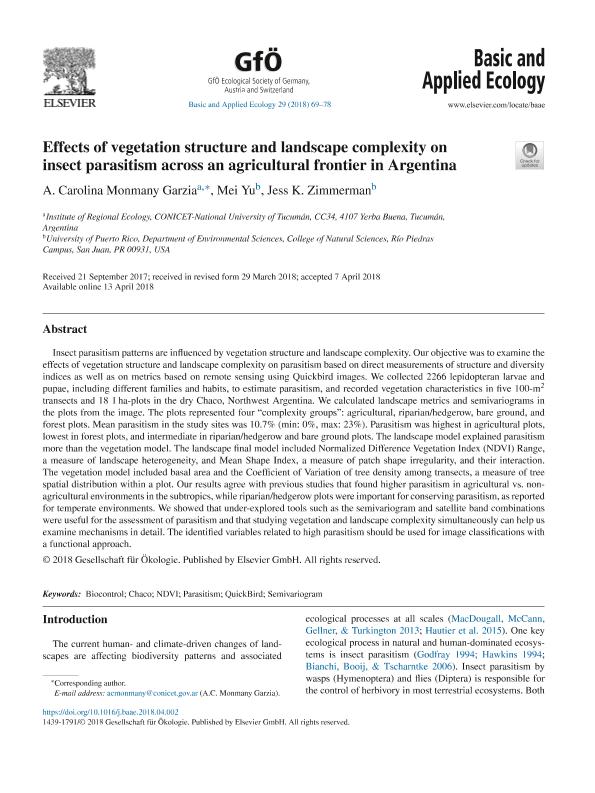Mostrar el registro sencillo del ítem
dc.contributor.author
Monmany, Ana Carolina

dc.contributor.author
Yu, Mei
dc.contributor.author
Zimmerman, Jess K.
dc.date.available
2019-09-17T20:35:05Z
dc.date.issued
2018-06
dc.identifier.citation
Monmany, Ana Carolina; Yu, Mei; Zimmerman, Jess K.; Effects of vegetation structure and landscape complexity on insect parasitism across an agricultural frontier in Argentina; Elsevier Gmbh, Urban & Fischer Verlag; Basic and Applied Ecology; 29; 6-2018; 69-78
dc.identifier.issn
1439-1791
dc.identifier.uri
http://hdl.handle.net/11336/83762
dc.description.abstract
Insect parasitism patterns are influenced by vegetation structure and landscape complexity. Our objective was to examine the effects of vegetation structure and landscape complexity on parasitism based on direct measurements of structure and diversity indices as well as on metrics based on remote sensing using Quickbird images. We collected 2266 lepidopteran larvae and pupae, including different families and habits, to estimate parasitism, and recorded vegetation characteristics in five 100-m2 transects and 18 1 ha-plots in the dry Chaco, Northwest Argentina. We calculated landscape metrics and semivariograms in the plots from the image. The plots represented four “complexity groups”: agricultural, riparian/hedgerow, bare ground, and forest plots. Mean parasitism in the study sites was 10.7% (min: 0%, max: 23%). Parasitism was highest in agricultural plots, lowest in forest plots, and intermediate in riparian/hedgerow and bare ground plots. The landscape model explained parasitism more than the vegetation model. The landscape final model included Normalized Difference Vegetation Index (NDVI) Range, a measure of landscape heterogeneity, and Mean Shape Index, a measure of patch shape irregularity, and their interaction. The vegetation model included basal area and the Coefficient of Variation of tree density among transects, a measure of tree spatial distribution within a plot. Our results agree with previous studies that found higher parasitism in agricultural vs. non-agricultural environments in the subtropics, while riparian/hedgerow plots were important for conserving parasitism, as reported for temperate environments. We showed that under-explored tools such as the semivariogram and satellite band combinations were useful for the assessment of parasitism and that studying vegetation and landscape complexity simultaneously can help us examine mechanisms in detail. The identified variables related to high parasitism should be used for image classifications with a functional approach.
dc.format
application/pdf
dc.language.iso
eng
dc.publisher
Elsevier Gmbh, Urban & Fischer Verlag

dc.rights
info:eu-repo/semantics/openAccess
dc.rights.uri
https://creativecommons.org/licenses/by-nc-sa/2.5/ar/
dc.subject
Biocontrol
dc.subject
Chaco
dc.subject
Ndvi
dc.subject
Parasitism
dc.subject
Quickbird
dc.subject
Semivariogram
dc.subject.classification
Ecología

dc.subject.classification
Ciencias Biológicas

dc.subject.classification
CIENCIAS NATURALES Y EXACTAS

dc.title
Effects of vegetation structure and landscape complexity on insect parasitism across an agricultural frontier in Argentina
dc.type
info:eu-repo/semantics/article
dc.type
info:ar-repo/semantics/artículo
dc.type
info:eu-repo/semantics/publishedVersion
dc.date.updated
2019-09-17T19:47:30Z
dc.journal.volume
29
dc.journal.pagination
69-78
dc.journal.pais
Alemania

dc.description.fil
Fil: Monmany, Ana Carolina. Universidad Nacional de Tucumán. Instituto de Ecología Regional. Consejo Nacional de Investigaciones Científicas y Técnicas. Centro Científico Tecnológico Conicet - Tucumán. Instituto de Ecología Regional; Argentina. Universidad Nacional de Tucumán. Instituto de Ecología Regional. Consejo Nacional de Investigaciones Científicas y Técnicas. Centro Científico Tecnológico Conicet - Tucumán. Instituto de Ecología Regional; Argentina
dc.description.fil
Fil: Yu, Mei. Universidad de Puerto Rico; Puerto Rico
dc.description.fil
Fil: Zimmerman, Jess K.. Universidad de Puerto Rico; Puerto Rico
dc.journal.title
Basic and Applied Ecology

dc.relation.alternativeid
info:eu-repo/semantics/altIdentifier/url/https://www.sciencedirect.com/science/article/pii/S1439179117301524
dc.relation.alternativeid
info:eu-repo/semantics/altIdentifier/doi/http://dx.doi.org/10.1016/j.baae.2018.04.002
Archivos asociados
